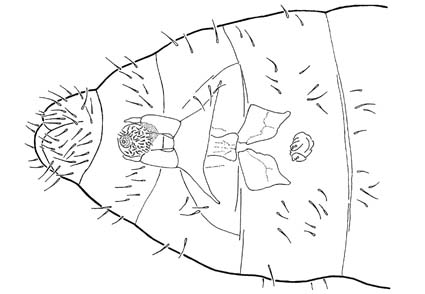Abstract
Two new species of the genus Pseudachorutes, namely P. hyrcanicus sp. nov. and P. kurdistanicus sp. nov., are described based on materials from different parts of Iran. P. hyrcanicus sp. nov. seem to be especially similar to Pseudachorutes dubius Krausbauer, 1898 and Pseudachorutes vitalii Kaprus’ & Weiner, 2009, two congeners with the same labral formula (4/2,3,4), shape of apical bulb (trilobed) and details of chaetotaxy (unpaired chaeta d1 present and a0 absent on head, a2 chaeta absent on Tht. II and III, m row chaetae present on Abdt. IV, tibiotarsi I-III with 18, 18, 17 chaetae respectively), but are distinguished by the number of chaetae on Tht. I (4+4 in P. dubius, 3+3 in P. vitalii and P. hyrcanicus sp. nov.) and Abdt. IV (11+11 in P. dubius and P. hyrcanicus sp.nov. and 14(15) + 14 in P. vitalii), number of teeth at mandible (two in P. dubius and P. vitalii and four in P. hyrcanicus sp.nov.) and claw (lateral teeth present in P. dubius and P. vitalii and absent in P. hyrcanicus sp.nov.). Pseudachorutes kurdistanicus sp. nov. is related to P. laricis Arbea & Jordana,1989 and P. vasylii Kaprus’ & Weiner, 2009 because of the same type of chaetotaxy of head (d1 chaetae present and a0 chaeta absent), Tht. I (3+3 chaetae), Tht. II-III (without a2 chaeta), Abdt. IV (m row chaetae absent), Abdt. V (a2 and p2 chaetae absent) and the absence of lateral teeth on claws. The last three species differ in number of vesicles in PAO (11–12 in P. kurdistanicus sp. nov., 4–6 in P. vasylii and 7-9–7-9 in P. laricis), shape of apical vesicle on Ant. IV. (trilobed in P. kurdistanicus sp. nov. and simple or slightly bilobed in the other two species), labral formula (4/2,3,4 in a new species, 2/2,3,3,4 in P. laricis and 2/3,3,4 in P. vasylii) and number of chaetae on tibiotarsi I-III (18, 18, 17 in a new species and 19, 19, 18 in the other two species). An identification key of the species of Pseudachorutes recorded so far from Iran is given.
References
Arbea, J.I. & Jordana, R. (1989) The Genus Pseudachorutes (Collembola, Neanuridae) from Navarra (Northern Iberian Peninsula), with description of a new species and a new subspecies. Mitteilungen der Schweitzerischen Entomologischen Gesellschaft, 62, 157–166.
Bellinger, P.F., Christiansen, K.A. & Janssens, F. (1996–2022) Checklist of the Collembola of the World. Available from: http://www.collembola.org (accessed 28 February 2022)
Börner, C. (1901) Neue Collembolenformen und zur Nomenclatur der Collembola Lubb. Zoologischer Anzeiger, 24 (657/658), 696–712.
Deharveng, L. (1983) Morphologie évolutive des Collemboles Neanurinae en particulier de la lignée Neanurienne. Travaux du Laboratoire d’Écobiologie des Arthropodes Édaphiques, Toulouse, 4 (2), 1–63.
Jordana, R., Arbea, J., Simón, C. & Luciáñez, M.J. (1997) Collembola, Poduromorpha. In: Ramos, M.A., Alba, J., Bellés, X., Gosálbez, J., Guerra, A., Macpherson, E., Martín, F., Serrano, J. & Templado, J. (Eds.), Fauna Ibérica. Vol. 8. Museo Nacional de Ciencias Naturales, CSIC, Madrid, pp. 1–807.
Kaprus’, I.J. & Weiner, W. (2009) The genus Pseudachorutes Tullberg, 1871 (Collembola, Neanuridae) in the Ukraine with descriptions of new species. Zootaxa, 2166 (1), 1–23. https://doi.org/10.11646/zootaxa.2166.1.1
Krausbauer, Th. (1898) Neue Collembola aus der Umgebung von Weilburg a./Lahn. Zoologischer Anzeiger, 21 (568), 501–504.
Massoud, Z. (1967) Monographie des Neanuridae, Collemboles Poduromorphes à pièces buccales modifiées. In: Delamare Deboutteville, C. & Rapoport, E.H. (Eds.), Biologie de l’Amérique Australe. Vol. 3. CNRS, Paris, pp. 7–399.
Schäffer, C. (1896) Die Collembola der Umgebung von Hamburg und benachbarter Gebiete. Mitteilungen aus dem Naturhistorischen Museum in Hamburg, 13, 149–216.
Shayanmehr, M., Yoosefi Lafooraki, E. & Kahrarian, M. (2020) A new updated checklist of Iranian Collembola (Arthropoda: Hexapoda). Journal of Entomological Society of Iran, 39 (4), 403–445. https://doi.org/10.22117/jesi.2019.124366.1285
Stach, J. (1949) The Apterygotan Fauna of Poland in relation to the World-Fauna of this group of Insects. Families: Anuridae and Pseudachoritidae. Polska Akademia Umiejętności, Acta Monographica Musei Historiae Naturalis, Kraków, 122 pp
Tullberg, T. (1871) Förteckning öfver Svenska Podurider. Öfversigt af Kongliga Vetenskaps-Akademiens Förhandlingar, 28, 143–155.


